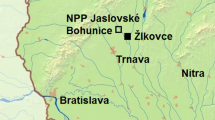Abstract
Carbon-14 is a radionuclide with global occurrence and partly natural origin. The main anthropogenic sources of the 14C were the nuclear weapon tests, namely at the beginning of the 1960s, nowadays the nuclear energy facilities are the main sources. Maximum in the atmospheric 14C activity was observed in 1963. In the following years the considerable 14C activity decrease was due to intensive carbon deposition into oceanic water and sediments particularly. At present the 14C activity approximates the level before nuclear age, corresponding to ∼0 ‰ Δ 14C. Another actual type of anthropogenic influence is the Suess effect, i.e., the dilution of 14C by fossil carbon (fuel combustion). This effect causes a decrease of the 14C activity on a global, regional and local scale. Thus, monitoring of actual reference level of 14C activity gives a possibility to indicate local or global anthropogenic influences. This paper reporting data from the atmospheric 14CO2 monitoring in the Czech Republic and Hungary compares the actual results with other European countries. The observed effects connected with local and regional CO2 releases from fossil fuel combustion are discussed.
Similar content being viewed by others
References
Report of the U.N. Scientific Committee on the Effects of Atomic Radiation to the General Assembly: “Exposures from natural and man-made sources of radiation”, rep. 1, 2000.
Meijer H. A. J., Van der Plicht, J., Gislefoss, J. S., and Nydal, R.: Radiocarbon 37 (1995) 39.
Reimer P. J., Brown T. A. and Reimer R. W.: Radiocarbon 46 (2004) 1299.
Suess H. E.: Science 122 (1955) 415.
Kuc T. and Zimnoch M.: Radiocarbon 40 (1998) 417.
Stuiver M. and Polach H. A.: Radiocarbon 19 (1977) 355.
Světlík I., Mirchi R., Michálek V. and Tomášková L.: In: Proc. XXVII Days of Radiation Protection, Liptovsky Jan 2005, Slovakia 2005, p. 220.
Gupta S. K. and Polach H. A.: Radiocarbon dating practises at ANU, ANU 1985, Canberra.
Uchrin G. and Hertelendi E.: Development of a reliable differential Carbon-14 sampler for environmental air and NPP stack monitoring. Final Report of the OMFB contract No. 00193/1991 (in Hungarian), 1992.
Csongor É. and Hertelendi E.: Nuclear Instruments and Methods in Physics Research „B” 17 (1986) 493.
Hertelendi et al.: Radiocarbon 31 (1989) 399.
Csongor É., Szabó I. and Hertelendi E.: Radiochem. and Radioanal. L. 55 (1982) 303.
Hertelendi E.: Radiocarbon 32 (1990) 283.
Hertelendi E. et al.: In: Proc. 4th Working Meeting Isotopes in Nature. Leipzig, 1986. (Eds. U. Wand and G. Strauch) Akademie der Wissenschaften der DDR Zentralinstitut für Isotopen und Strahlenforschung, Leipzig, 1987, 323.
Levin, I. and Kromer, B.: Radiocarbon 46 (2004) 1261.
Author information
Authors and Affiliations
Rights and permissions
About this article
Cite this article
Světlík, I., Tomášková, L., Molnár, M. et al. Monitoring of atmospheric 14CO2 in central European countries. Czech J Phys 56, D291–D297 (2006). https://doi.org/10.1007/s10582-006-1030-5
Issue Date:
DOI: https://doi.org/10.1007/s10582-006-1030-5




